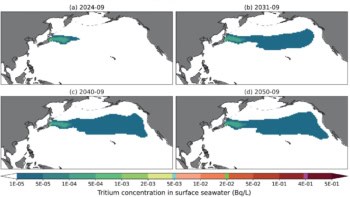One year on from an earthquake and subsequent tsunami that crippled the Fukushima Daiichi nuclear power plant in Japan, Mike Weightman says that the quest to improve nuclear safety must never stop

At 2.46 p.m. local time on 11 March 2011 the biggest earthquake recorded in Japan occurred off the country’s east coast. The magnitude-9 earthquake was one of half a dozen earthquakes greater than magnitude 7 to occur on that day. Within an hour, the first of a series of massive tsunamis hit that caused catastrophic damage and loss of life across Japan. The tsunami also led to a serious nuclear accident at the TEPCO Fukushima Daiichi site, with repercussions felt across the international community.
As time went on, the number of dead from the earthquake and tsunami started to rise: final estimates suggest 20,000 people died or are missing. More than 100,000 homes were damaged or destroyed, with whole villages and towns swept away. The disaster is on a scale that we can only imagine here in the UK. Even for Japan, which experiences high seismic activity, it was unimaginable.
In the UK, the Office for Nuclear Regulation (ONR) responded by setting up the Redgrave Court incident suite to provide expert advice for the UK government on the implications for the 17,000 UK citizens in Japan. We also required all of our licensed nuclear sites to promptly answer questions and justify the ongoing safety of their operations. For more than two weeks we operated our incident suite and provided advice to the Cabinet Office Briefing Room – the UK’s crisis response committee – and to John Beddington, the UK government’s chief scientific adviser. After this, as requested by the secretary of state for energy and climate change, we set about producing an interim report on the implications for the UK nuclear industry.
Getting back on track
At about the same time, it was with great honour and no little humility that I accepted an invitation from the International Atomic Energy Agency (IAEA) to lead a team of nuclear experts from around the world on a fact-finding mission to Japan from 24 May to 1 June 2011.
The earthquake and tsunami particularly affected the five nuclear plants along the Japanese east coast. My IAEA team visited three of them: Tokai, Fukushima Daiichi and Fukushima Daini. At all these sites I encountered tales of bravery, leadership and resilience. Workers at the Daini site laid 9 km of heavy power cabling by hand in 16 hours to ensure initial safety systems worked to cool and control the reactors, while those at the stricken Daiichi plant had to resort to novel means, using what they had to hand in attempts to secure cooling of the reactor.
I was particularly impressed by the commitment of the several-hundred-strong workforce at the Daiichi site, who all stayed on for days after the tsunami struck, despite not knowing whether it had affected their villages and put their families at great risk. This type of uncompromising loyalty and determination is commonplace in Japan; it is testament to the country’s spirit that its people approached the disaster with characteristic stoicism, discipline and organization. Everyone I encountered was willing to help with total openness and transparency.
Looking back, the visit achieved its aim to identify lessons from which the whole world can learn. Ultimately, it appears that the Japanese authorities underestimated the hazard presented by the tsunami. This was despite adequately estimating the hazard presented by the earthquake.
The magnitude-9 earthquake caused severe ground motions that lasted for several minutes at the Daiichi plant. The measured motions reasonably matched the predictions of the designers of the seismic protection measures. Upon detection of these ground motions, the safety systems at Daiichi shut down the reactors and started the back-up systems. All the evidence I have seen, including the evidence at the other Japanese nuclear power plants that witnessed similar ground motions, supports the view that the Daiichi plant safely survived this massive earthquake.
However, the flood protection measures at the Daiichi plant were originally designed to withstand a 3.1 m high tsunami, whereas the largest wave that crashed into the site in March inundated it to around 15 m. A review in 2002 by the operators of the Daiichi plant did result in increases to the tsunami defences to enable it to better survive a 5.7 m high tsunami. This improvement still proved to be inadequate, especially considering the history of tsunamis along that coast over the past century.
Lessons learned
The IAEA team presented a summary report to the Japanese Government on 1 June and, later that month, presented its full report to a ministerial meeting in Vienna, at which the world community sought to learn lessons from Fukushima. In response to a request from the secretary of state, I have produced two reports (with massive help from colleagues in the ONR and elsewhere) on lessons for the UK nuclear industry – an interim report in mid-May and a final report in September 2011.
My final report reaffirmed the conclusions and recommendations in my interim report and added to them, resulting in 17 conclusions and 38 recommendations in total. Overall, I remain confident that there are no fundamental weaknesses in the regulation of the UK nuclear industry or indeed in the industry itself. We have a consistent and well-founded approach to safety assessment in the UK , including for extreme natural hazards. Additionally, the affected reactors at the Daiichi plant were all boiling-water reactors, which do not form part of the UK fleet. The UK reactors are either advanced gas-cooled reactors or, in the case of Sizewell B, one of the most modern pressurized-water reactors in the world. The UK is also far from any edge of a tectonic plate and therefore is not at risk from frequent or extreme seismic activity (and their subsequent tsunamis). Although this is reassuring, this is not a time for complacency, hence my 38 recommendations.
All nuclear power plants in the UK and across Europe have undertaken a “stress test” to identify whether any improvements can potentially be made. We submitted the UK national report on stress tests in December and it is published on the ONR website. I have also required all non-power-plant licensed nuclear installations in the UK to undertake similar tests of relevant safety margins. The outcome of these stress tests will be added to the outcome of my already published reports. The aim of all these activities will be to transparently and openly ensure that the UK government, nuclear regulator and nuclear industry are doing all that they can to ensure the highest levels of nuclear safety both at home and across the world.
I have always said that safety is founded on the principle of continuous improvement. The ONR already requires protection of nuclear sites against the worst-case scenarios that are predictable for the UK, but no matter how high our standards, the quest for improvement must never stop. We will ensure lessons are learned from Fukushima. In many cases, action has already been taken, but work will continue to learn the lessons.



